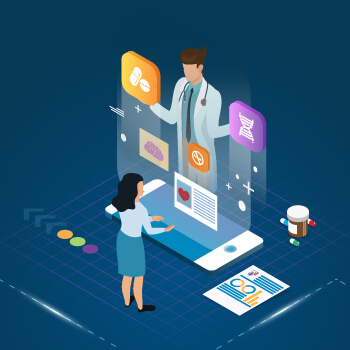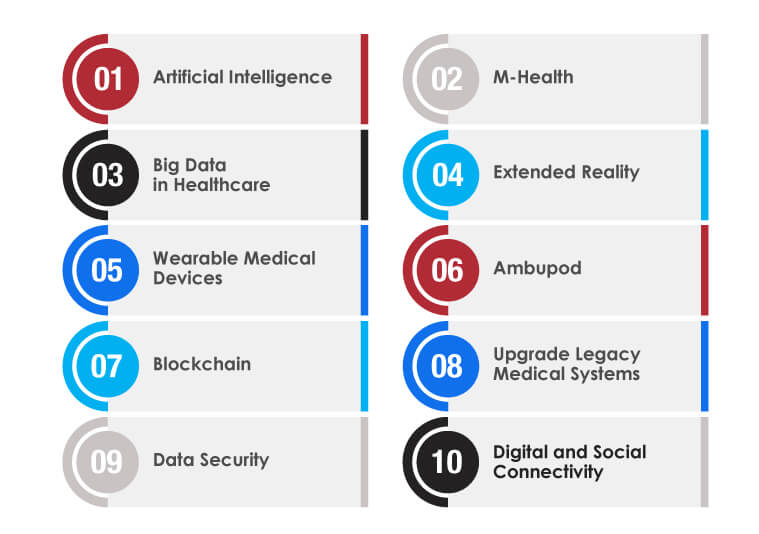Published: 30 Apr 2024
Top 10 Digital Transformation in Healthcare Trends for 2024
The healthcare industry has undergone several challenges in the last couple of years. These challenges vary from global COVID-19 pandemic to demographic shifts and the evolving patient care demands. Now, we are in the age of personalized healthcare, digital customer service, and evidence-based medicine. It becomes necessary for healthcare organizations, entrepreneurs, and startups to stay updated about the latest trends in the evolving industry.
For example, remote patient monitoring and using AI in diagnostics helps reduce in-person visit rates, decrease the burden on healthcare facilities, and enable personalized care. Additionally, data analytics facilitates better decision-making and efficient resource management, improving operational efficiencies and patient care outcomes. However, digital transformation in healthcare is more than that. It involves implementing ML for personalized medicine and using AI to detect disease symptoms easily in areas like dermatology, pathology, radiology, etc. Although these are just examples, digital transformation does play a crucial role in optimizing healthcare operations.
Importance of Digital Transformation in Healthcare Industry

Government schemes and incentives are not the only reason to undergo digital transformation in the healthcare industry. It is a win-win situation for patients and practitioners alike. Digital healthcare solutions benefit in the following ways:
• Digital technologies like telehealth, wearable devices, and AI-enabled diagnostics facilitate continuous monitoring and real-time analytics. It results in accurate diagnostics and personalized patient treatment plans, which improves patient care.
• Digital transformation diminishes geographical barriers to healthcare access. Telemedicine allows patients living in remote or underserved areas to receive online consultations and care without traveling far, making healthcare more inclusive.
• Automation and AI help streamline administrative tasks like scheduling, compliance checks, and billing. This reduces overhead costs and allows healthcare providers to focus on patient-centric tasks rather than wasting time on paperwork.
• Digital systems integration helps collect, store, and analyze health data efficiently. This aids in medical research and improves system planning and resource allocation.
• Big data analytics and prediction models can identify at-risk populations early, enabling healthcare interventions before conditions become chronic or critical. This shifts the focus from treatment to prevention.
Top 10 Digital Transformation Trends in Healthcare for 2024

According to a survey, only 7% of healthcare and pharmaceutical companies have gone digital, compared to 15% in other industries. Despite that, the US healthcare market is projected to reach $5.7 trillion by 2026. To transform standard practice into an innovative digital machine in 2024, businesses need a comprehensive view of the modern healthcare environment. Here’s a better look at the top 10 digital transformation trends for healthcare industry in 2024:
Artificial Intelligence:
According to a Morgan Stanley research report, the healthcare industry’s spending on AI and ML will surpass 10.5% by the end of 2024. AI applications in healthcare range from communication with patients to pharmaceutical research and assisting with surgeries. It also automates data management, starting with document processing, EHR management, genomics, wearable device data, and medical imaging. Healthcare providers can improve information processing and decision-making to improve the efficiency of the drug research process. For example, AI technology, AlphaFold2, helped predict the 3D structure of proteins from amino acid sequences. It is openly available via Google Colab. Another example is DeepAffinity, a semi-supervised model that syncs recurrent and convolutional neural networks to predict the binding affinity between a drug and target sequences.
M-Health:
Mobile health or M-Health allows patients to manage their health more effectively. It involves using smartphones and other wireless technologies to monitor health, schedule doctor appointments, and access medical resources more conveniently. It is also crucial in preventive healthcare, telemedicine, and chronic disease management. As of 2024, the number of smartphone users worldwide will reach 7.1 billion. M-health growth aligns well with the digital transformation in healthcare, driving advancements in tech-savvy and patient-centric care delivery. Given the growing number of smartphone users and the potential for more in upcoming years, online healthcare will surely have a large market.
Big Data in Healthcare:
Big data collects information about a business via social media, eCommerce, online transactions, and financial records, identifies patterns, and analyzes trends for the future. In the case of the healthcare sector, it aids in disease prediction, personalized medicine, and improving healthcare delivery efficiency. A high volume of patients entering emergency rooms is recurring, known as frequent flyers. Their number counts for up to 28% of visits. Big data analytics can help identify these patients and create preventive health plans to keep them from returning. It could also help healthcare providers estimate admission rates, which will be beneficial in allocating proper staff to deal with patients. It will save money and resources, thus reducing waiting time for emergency rooms.
Extended Reality:
Extended reality combines AR, VR, and mixed reality under a single umbrella, which can be innovative and beneficial in the healthcare sector. From assisting in surgery to enhancing telehealth, AR/VR solutions can be a game-changer in the healthcare industry. These technologies could enable remote consultations and telemedicine, allowing medical practitioners to share real-time visual data and guidance with patients. AR can help craft captivating and interactive exercises for rehabilitation and physical therapy patients. VR can help create virtual training sessions for doctors to enhance their skills and knowledge of medical practices. It can also be used in certain treatments. For instance, VR medical centers leverage VR therapy to aid patients dealing with phobias, such as fear of water, heights, etc., and PTSD.
Wearable Medical Devices:
Wearable medical devices are another digital transformation trend in healthcare. Companies use these devices to collect health data to improve the quality and reliability of their medical devices. Looking a decade back, people were comfortable with undergoing physical treatment once a year or checking with doctors when something was majorly wrong. However, in the current digital age, patients focus on prevention and maintenance as soon as possible and demand their health information more frequently. Due to this, healthcare providers are investing in wearable device technology to provide up-to-date monitoring details of patients to determine the chances of major medical scenarios. Some examples of wearable devices are heart rate sensors, exercise trackers, oximeters, sweat meters, etc.
Ambupod:
Ambupod is a digitally adept ambulance that transmits real-time health data of patients to hospitals. It is equipped with the latest medical equipment, telemetry devices, and patient monitoring tools. Paramedics can use these devices to transmit patient data seamlessly in real-time, allowing hospitals to provide immediate care to patients with serious conditions in the ambulance.
Blockchain:
Because of the recent cryptocurrency bubble burst, blockchain developed a bad reputation. Ordinary people consider it a vague and puzzling concept that will not impact their lives too much. But the reality is far from it. Soon, it will play a crucial role in keeping EHRs accurate and safe. Blockchain is a transactions computerized database or a digital ledger shared across a network to allow users to safely exchange financial data with suppliers without involving third parties like banks. According to recent reports, the blockchain healthcare market is expected to reach $29.76 billion by 2029. Many pharmaceutical and healthcare industries already support this technology and invest millions in this market.
Upgrade Legacy Medical Systems:
According to research by McKinsey and Deloitte, the crucial factors in successful digital transformation include mapping a clear strategic path and setting a cultural mindset shift. A report by Kaspersky Lab revealed that 73% of healthcare systems still use legacy operating systems to operate medical equipment. This makes them vulnerable to security breaches and prevents them from keeping up with changing patient expectations. Hence, migrating from legacy medical systems to modern operating systems or re-engineering them according to specific requirements and technical feasibility would trend in 2024. The modernization efforts must facilitate seamless data exchange with other healthcare systems, including laboratory information systems and EHRs.
Data Security:
Efficiency and quality care, privacy, and security are important in the healthcare industry. They are critical priorities. Postmeds, a healthcare company that does business as Truepill and provides mail-order prescriptions for pharmacies, suffered a massive data breach in 2023, affecting 2,364,359 users worldwide. It has become necessary to ensure that healthcare organizations are HIPAA-compliant7 Key Benefits of Big Data Analytics in Healthcare to avoid costly data breaches. Organizations serving international patients should go through GDPR in the European Union. If the healthcare provider wants to exchange ePHI with patients via third-party software, they must analyze and go through the process of obtaining a business associate exception with the vendor. One can even partner with a data security testing expert to protect digital information from unauthorized access and cyber threats.
Digital and Social Connectivity:
Social media has become a common ground for people to share their thoughts and for industries to pick up on new trends. According to a report, an average person spends about 194 minutes daily on social networking sites. Healthcare providers understand the omniscience of social media and leverage social media platforms to ask patients to share their concerns and seek advice. They can also use SM platforms to spread awareness about health-related information. As a digital transformation trend, SM’s purpose as a healthcare channel will reach new heights in the upcoming years.
Summary
The healthcare industry has faced numerous challenges recently, including the global shift to digital technology and evolving patient care demands. Implementing digital transformation technologies has become essential for healthcare providers to improve patient care, enhance accessibility, optimize operations, and facilitate preventive health measures. Key trends like AI, telemedicine, big data analytics, and extended reality are transforming healthcare services, making them more efficient and patient centric. However, digital transformation is a critical process that requires the support of a reliable digital engineering and QA provider like Tx.
How can Tx help Implement Digital Transformation in Healthcare industry?

• Partnering with digital engineering and QA experts, like Tx, can ensure that digital healthcare solutions are reliable, secure, and effective. This collaboration will help you adapt to new technologies confidently, enhancing their capabilities to meet modern healthcare demands. Such partnerships are pivotal in advancing healthcare quality and ensuring compliance with industry standards.
• We address various customer challenges associated with digital apps, such as functionality, performance, security, usability, cross-device compatibility, and more.
Our teams work closely with clients, using various methodologies (Agile and DevOps) to offer digital testing services for mobile and web applications.
• We cover E2E testing of medical and connected device testing, including validation and verification regulations like 21 CFR (Part 820, 11, 300, ISO (14971 & 62304), IQ/OQ/PQ, and compliance testing to ensure medical device software complies with required standards and regulations like HL7, FDA, and HIPAA.
• Our teams conduct a thorough risk analysis of the system with a mitigation plan and prioritize tests accordingly.
• We leverage AI to provide predictive analytics, enabling healthcare providers to anticipate potential bottlenecks and quality issues before they impact your digital transformation project.
• We have 80+ healthcare experts and external domain consultants who will be available on a need basis, with all the healthcare tools and technology expertise, and 50+ test consultants with in-depth and rich hands-on experience.
• Our in-house accelerators and dashboards (Tx-Automate, Tx-HyperAutomate digital transformation in healthcare, Tx-Insights, Tx-SmarTest, etc.) provide real-time insights into the QA progress, facilitating informed decision-making and seamless communication.
To know more, contact QA experts now.